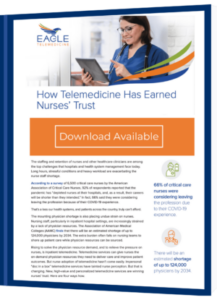The physician’s communication with a patient has a direct correlation to healthcare outcomes. Research finds that high-quality communication between patient and physician can improve adherence to treatment, reduce delays in diagnosis and build trust which facilitates the positive doctor-patient relationship that enhances psychological benefits during care.
Consider a visit to the ER. All a patient may be thinking about is the pain or fear they are experiencing during what can be an exceptionally stressful time. This fear can be exacerbated when the attending physician is present via virtual telemedicine technology. Despite an increased familiarity with virtual conferencing and communication, telemedicine is still not expected in times of emergency care. But as it becomes more commonplace, there are many ways physicians are taking a remarkable bedside manner to the web.day, telemedicine is every bit as effective as on-site care. In fact, many telehospitalists are becoming so experienced at delivering a great website manner that patients actually claim that the screen literally melts into the background during virtual physician care. Here’s how great telemedicine providers deliver an exceptional webside manner…
- Set expectations. When patients seek medical help, they expect to “SEE” the doctor. The best telemedicine providers recognize this right up front and work to build rapport and empathy early. By spending time to explain the process of telemedicine and how they are working closely with the attending on-staff clinicians for seamless care delivery, great telehospitalists are able to quickly build patient confidence.
- Show presence. One advantage telemedicine physicians have over on-site physicians is that they can be 100% present during the patient visit. They are not distracted by the surrounding patients’ needs or being pulled in multiple places at once as on-site hospitalists often are. Great telehospitalists will use this ability to be fully engaged during the patient visit to build an exceptional connection with empathy and compassion.
- Use clear language. Communication using technology requires extra attention to word choices, communication pace and articulation. When communicating with patients, great telemedicine providers are skilled at keeping language and word choices clear and positive. They also know that slowing down and leaving room for questions is important. In addition, using bite-sized phrases and descriptive terminology will help communicate complex medical terms clearly so that the patient can properly understand instructions and diagnoses. Finally, providers that have a sense of humor that’s polite and appropriate, can lighten the mood in stressful situations and connect better with patients and families.
- Manage body language. Unlike delivering care in person, the patient’s exposure to their telemedicine physician is limited to their facial presence. This makes body language more important than ever. Great telehospitalists are skilled at communicating with facial expressions that show their attention and understanding. They work hard to avoid looking distracted or admonishing and refrain from other unnerving body language such as fidgeting or slouching.
- Keep eye contact. In addition to body language, eye contact is vital. Directly connecting with the patient with eye contact shows the provider is interested, actively listening and respecting what the patient and attending family members have to say. This takes practice to look directly at the patient using telemedicine technology so that the provider doesn’t appear to be looking offscreen or awkwardly at the camera lens. Great telemedicine providers have perfected eye contact so that patients feel the screen disappear into the background like the physician is in the room right there with them.
When it comes to delivering virtual care, telemedicine providers take their webside manner as seriously as their bedside manner – even more. As telemedicine becomes more prevalent and virtual care more ubiquitous, the provider-patient relationship needs to evolve so that it continues to thrive in a virtual setting. By improving communication and taking additional steps to elevate engagement using virtual technology, telehospitalists will demonstrate that telemedicine can achieve patient outcomes on par with on-site care delivery models.
At Eagle Telemedicine, we have over 300 physicians that have perfected their virtual care delivery with an exceptional webside manner. Let us show you how we can deliver better patient experiences and outcomes. Learn more here.







